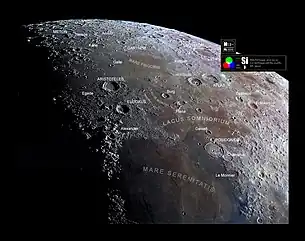Egede (crater)
Egede is the remains of a lunar impact crater that has been flooded by lava, leaving only the somewhat polygonal circumference of the rim protruding just above the mare. It was named after Dano-Norwegian natural historian Hans Egede.[1] It is located on the southern edge of the Mare Frigoris, to the west of the crater Aristoteles. To the southwest is an arc of low mountains curving between the rims of Aristoteles and Eudoxus. The floor of Egede is flat and nearly featureless, except for a few tiny craterlets, including secondaries from Aristoteles (which are also present to the north and south of Egede). The surviving rim has a maximum altitude of 0.4 km above the surface.
 Mosaic of Lunar Orbiter 4 images | |
| Coordinates | 48.7°N 10.6°E |
|---|---|
| Diameter | 37 km |
| Depth | Unknown |
| Colongitude | 350° at sunrise |
| Eponym | Hans Egede |


Satellite craters
By convention these features are identified on lunar maps by placing the letter on the side of the crater midpoint that is closest to Egede.
| Egede | Latitude | Longitude | Diameter |
|---|---|---|---|
| A | 51.6° N | 10.5° E | 13 km |
| B | 50.5° N | 8.9° E | 8 km |
| C | 50.1° N | 13.0° E | 5 km |
| E | 49.6° N | 10.4° E | 4 km |
| F | 51.9° N | 12.5° E | 4 km |
| G | 51.9° N | 6.9° E | 7 km |
| M | 49.5° N | 12.4° E | 4 km |
| N | 49.7° N | 11.1° E | 4 km |
| P | 47.8° N | 10.5° E | 4 km |
 Lunar Orbiter 4 image of Egede B
Lunar Orbiter 4 image of Egede B
References
- "Egede (crater)". Gazetteer of Planetary Nomenclature. USGS Astrogeology Research Program.
- Andersson, L. E.; Whitaker, E. A. (1982). NASA Catalogue of Lunar Nomenclature. NASA RP-1097.
- Bussey, B.; Spudis, P. (2004). The Clementine Atlas of the Moon. New York: Cambridge University Press. ISBN 978-0-521-81528-4.
- Cocks, Elijah E.; Cocks, Josiah C. (1995). Who's Who on the Moon: A Biographical Dictionary of Lunar Nomenclature. Tudor Publishers. ISBN 978-0-936389-27-1.
- McDowell, Jonathan (July 15, 2007). "Lunar Nomenclature". Jonathan's Space Report. Retrieved 2007-10-24.
- Menzel, D. H.; Minnaert, M.; Levin, B.; Dollfus, A.; Bell, B. (1971). "Report on Lunar Nomenclature by the Working Group of Commission 17 of the IAU". Space Science Reviews. 12 (2): 136–186. Bibcode:1971SSRv...12..136M. doi:10.1007/BF00171763. S2CID 122125855.
- Moore, Patrick (2001). On the Moon. Sterling Publishing Co. ISBN 978-0-304-35469-6.
- Price, Fred W. (1988). The Moon Observer's Handbook. Cambridge University Press. ISBN 978-0-521-33500-3.
- Rükl, Antonín (1990). Atlas of the Moon. Kalmbach Books. ISBN 978-0-913135-17-4.
- Webb, Rev. T. W. (1962). Celestial Objects for Common Telescopes (6th revised ed.). Dover. ISBN 978-0-486-20917-3.
- Whitaker, Ewen A. (1999). Mapping and Naming the Moon. Cambridge University Press. ISBN 978-0-521-62248-6.
- Wlasuk, Peter T. (2000). Observing the Moon. Springer. ISBN 978-1-85233-193-1.
